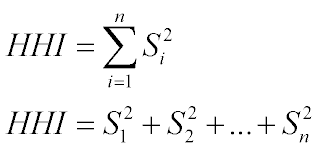Herfindahl-Hirschman Index (HHI)
Note: The article contains an abstract presentation of the material. See also: concentration index (CR).
The Herfindahl-Hirschman Index (HHI) is an indicator of the level of market monopolization, defined
as the sum of the squares of the percentage market shares occupied by each participant.
The HHI, also found in literature as the Herfindahl-Girschman Index, allows one to assess the level
of monopolization of a specific market. Therefore, in a number of countries (particularly in the USA),
it is used as an indicator determining the need to obtain permission for mergers and acquisitions from
the antimonopoly service.
Herfindahl-Hirschman Index Formula
The formula for calculating the Herfindahl-Hirschman Index (HHI) is:

Where:
Thus, the Herfindahl-Hirschman Index is equal to the sum of the squares of the percentage shares
of each market participant.
Practical Application
It is extremely rare to find a situation where it is possible to clearly identify absolutely all market participants
and their market shares. Therefore, for practical application, the formula takes into account the largest players
in descending order of their market share (influence). Players with extremely low market share values do not
have a significant impact on the calculation of the index value. For a practical calculation of the
Herfindahl-Hirschman Index value, you need to first take the largest player, then a smaller one, and continue
calculating until the index value stops changing significantly.
Assessing the Value of the HHI Index
If we had to add not the squares of the percentage market shares, but only their usual percentage values, no
matter how the market is distributed between the participants, we would still get 100% in the end. But if we
square each share, the situation will look radically different. Let's show this with an example:
-
Perfect Competition: If we assume that we are in a market with perfect competition, all sellers have
the same market share, for example, 1% (accordingly, there are 100 of them). Then the value of the index
will be:
12 х 100 = 100
22 х 50 = 200
42 х 25 = 400
-
Oligopolistic Situation: In an oligopolistic situation, for example, 10 private traders and 10% of the market,
the value of the Herfindahl-Hirschman Index will be:
102 х 10 = 1000
As we can see, with an arithmetic reduction in the number of market participants, the value of the HHI grows
exponentially.
Maximum Value of the Herfindahl-Hirschman Index
The maximum value of the Herfindahl-Hirschman Index is easy to determine. This is a state of complete and
absolute monopoly - there is one participant in the market with a market share of 100%.
1002 х 1 = 10 000
Thus, the maximum theoretical value of the HHI index is 10,000.
Segmentation of Markets by Monopolization Level
Returning to the practice of applying antitrust legislation in the USA, the American legislator believes that with an
HHI value of less than 1000, the market is free, and regulation of mergers and acquisitions is not required. With
an HHI level of more than 1000, regulatory authorities come into force, and permission from government agencies
is required. If the HHI exceeds 1800, the market is considered highly monopolized, and each such case is
investigated to make a decision.
In principle, the classification by the level of competition can be any. However, based on our example, we will derive
three main groups:
-
Group I: Markets with a high level of monopolization (concentration) (monopolistic markets)
1800<HHI<10000
-
Group II: Markets with a strong level of monopolization (concentration) (oligopolistic markets)
1000<HHI<1800
-
Group III: Markets with a low level of monopolization (concentration) (competitive markets)
HHI<1000
For simpler assessments of the level of concentration in the market, the concentration index (CR) is used.
Concentration Ratio (CR) |
Описание курса
| Assessment of the level of market concentration (monopolization)
|

